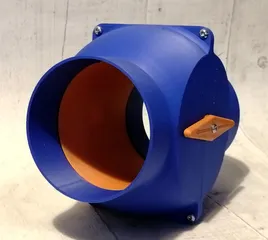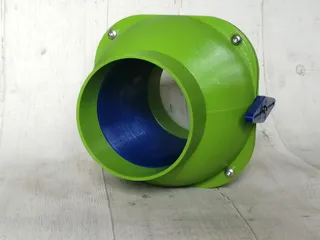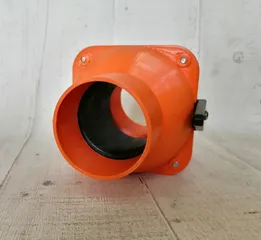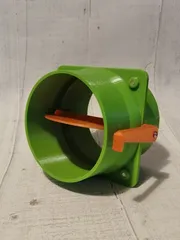Store & Use Sealed Filament Container
Description
PDFUpdate 21Mar24
Additional desiccant cage lid with integrated molecular sieve symbol (needs filament colour change)
Update 04Sep22
Improved desiccant cage. The new 3-part design is in a basket weave style, with screw on base & lid (Desiccant basket.stl, Dessicant Basket Base.stl., & Desiccant Basket Lid.stl). This prints faster than the original design, and doesn't require print supports (if the lid & base are printed top down to the build plate). I've updated my desiccant to molecular sieve type 3A because this desiccant has a greater affinity for water than silica gel and, more importantly, a greater affinity for water than the filament (which silica gel does not seem to have)! The beads can be dried in a borosilicate glass jug (pyrex) in a microwave oven (I dry 30g of beads in ~3 minutes at 1000W, and use 10g of beads in each basket). Molecular sieve desiccant loses it's high affinity for water at about 20% w/w (weight of beads/weight of water) but can hold up to about 40% w/w at lower drying efficiency (still better than silica gel!) To ensure I keep my filament as dry as possible, I have therefore incorporated a …
Hygrometer. Having tried and rejected other types of hygrometer, I've bought 14 round white plastic hygrometers from Aliexpress, so that I have one for each filament box. They're very cheap and surprisingly precise (they read the same as each other ±1 digit and are consistent across a wide range of relative humidity) although they are not accurate at low humidity. I worked out a calibration chart for my first 3 hygrometers by generating different RH values using saturated salt solutions based on a paper by Lewis Greenspan of the Institute for Basic Standards, National Bureau of Standards, Washington, D.C. (Journal of Research of the National Bureau of Standards - A, Physics and Chemistry Vol. 81A, No. 1, January-February 1977, "Humidity Fixed Points of Binary Saturated Aqueous Solutions"). I've included the chart with the documentation for this project, but if one keeps the humidity readings in the filament container below about 25% RH the filament prints well.
I've drilled a 42mm hole in each box using a hole saw (see photo for positioning to avoid contact with the filament reel) and sealed in each hygrometer with hot-melt glue.
Cable Glands. I've swapped out the PC4-M6 pneumatic connectors for nylon cable glands in size PG9, suitable for 4mm to 8mm PTFE tube. They're much better and don't scrape the filament or PTFE tube when pulling through the hole.
https://www.switchelectronics.co.uk/pg9-black-nylon-cable-gland-ip68
Original Post…
Looking around, the commercially available filament reel containers are expensive. The non-commercial solutions seem quite large and not handy for use, so I set to...
This filament storage container is based on an easily available, relatively cheap, clip-sealed, food storage container, with fairly easy to print parts. Some of the parts are inspired by Things 3376951 (thanks to VICLER) and 2070272 (thanks to butchja), but reworked from scratch in Onshape (link below).
The spool holder clamp accommodates a variety of centre hole diameters from about 40mm to about 77mm. I have one brand of spool (Miro) that is wider at one side than the other (83mmØ stepping in to 53mmØ after 11.7mm) - I either use this spool design with the wider side uppermost (and the filament coming off the spool in the opposite direction), or tolerate a little friction of the spool side resting on the Spool Holder Corner struts. The short clamp thread works (just!) with the wide cardboard spools from Ooznest (80mm deep). The long clamp thread is 19mm longer that the short one (so, in theory, would work with a spool 99mm deep).
I use these boxes sat on top of my Anycubic Kossel Linear Plus, held in place by the 2 Small Box Brackets and 1 Large Box Bracket (I suppose they're also partly held in by the caps that I've fitted to the top corners of the frame - Thing 2731456, thanks to Thump2010). The filament exits the box through one of the Pneumatic Connectors and down a 50cm length of 4mm OD 2mm ID PTFE tube and into my extruder. (My extruder is an E3D Titan, fitted at half the printer height to the outside face of the left side leg of the printer, and is fed from the top. You may need a different length of guide tube.)
When the filament is not in use, the filament is pulled back out of the extruder and unhooked (don't push it back into the box or you'll unwind and potentially tangle your filament). You can either open the box lid and rotate the reel to wind the filament back, leaving a short length of filament protruding to grab for the next use, or just push the filament extracted from your Bowden tube (or direct extruder!) into the box through the other Pneumatic Connector, into which you also push the PTFE tube. The box is then sealed for storage. When printing, I seal the box by inserting a short length of PTFE tube (~25mm), with it's inner diameter sealed, into the open Pneumatic Connector.
To make this, you need to print:
4 off Spool Holder Corner
2 off Small Box Bracket (only if you intend to use the box resting on top of the Kossel frame)
1 off:
Large Box Bracket (only if you intend to use the box resting on top of the Kossel frame)
Spool Holder Base
Clamp Thread (short)
Clamp Knob
Desiccant basket
and Clamp Thread (long) if you need to accommodate wider spools.
The short clamp thread works with the wide cardboard spools from Ooznest.
You also need these parts...
There are many sources of the pneumatic connectors, but these have the O-ring
PC4-M6 Pneumatic Connectors - Amazon B07P3BC4GQ
I used stainless steel half nuts to clamp the pneumatic connectors through the side wall of the container - these are nuts of half the usual thickness.
M6 A2 Stainless Hexagon Half Nuts (GWR Fasteners on ebay, item number 291748724121)
GWR Fasteners can also supply M3 x 8mm socket head bolts to fit the Small Box Brackets and the Large Box Bracket if you're going to use them. You'll also need some M3 T-nuts.
There are various sources of 608RS skateboard bearings in a variety of colours and ABEC standards. I got mine from ebay.
8x22x7mm ABEC-5 608RS Skateboard Bearings (item number 392604796294)
You need a suitable length of 4mm OD 2mm ID PTFE Bowden tube to connect the filament in the box to your extruder (any colour you like!).
There are many sources for this (including ebay item number 293211439475)
The container is available from the larger Sainsbury's supermarkets. Those most local to me only seem to stock 2 containers at a time (I have all that I need, which is why I'm telling you now!)
Sainsbury's 5l Klip Lock Container (Item code 131431388) - https://preview.tinyurl.com/u7nzmaw (direct link = https://tinyurl.com/u7nzmaw).
I use 10g colour indicating desiccant bags in the desiccant basket (the desiccant turns from yellow to green when wet).
20x Self-Indicating Yellow Silica gel Pouches 10g - Amazon B07M9YLH7T
You'll also need some self-adhesive hook and loop type fastener (Velcro) to act as a motion damper. You only need the loop side (if you can get just that!), about a 40mm length of 20mm wide for each spool holder.
All the printed parts were drawn in Onshape. https://preview.tinyurl.com/w57hhma (direct link = https://tinyurl.com/u7nzmaw)
Print Settings
Printer Brand:
Anycubic
Printer:
Kossel
Rafts:
No
Supports:
No
Resolution:
0.2mm / 0.25mm (doesn't matter except for looks!)
Infill:
10% to 20% (doesn't matter except for looks!)
Filament: Esun / Ooznest PLA+ / PLA Pro
Blue / Black (doesn't matter ...)
Notes:
The Desiccant Cage STL incorporates supports at the base, 3 at each side. These need to be removed and snap off easily (if printed in PLA!). The supports are on rafts, so should be easily identifiable.
Post-Printing
ASSEMBLY
You may need to run the Clamp Knob up and down the Clamp Thread a few times to ensure that it turns freely.
Carefully drill two 6mm holes in one side of the Container/box. These seem best placed at 25mm from the adjacent side and 50mm from the box base (see photo). Fit Pneumatic Connectors into the holes and fasten in place with M6 half nuts on the threads of each connector protruding inside the box. Don't overtighten or you may cause splitting away from your drilled hole.
Check the fit of the 608 skateboard bearings on the spindle on the Spool Holder Base. If they are not a tight fit (but fairly easily removable) you will either need to sand away the spindle with abrasive paper of a small file, or use tiny blobs of hot melt glue (be careful not to melt your printed piece with the glue gun nozzle) to fatten the shaft in key places.
Cut the 40mm Velcro loop strip into four 10mm strips and stick onto the top of the Spool Holder Base where they will "interfere" and act as a brake/damper to prevent the Clamp Thread (& hence the filament reel) overrotating and loosening, and potentially tangling, your filament (see photo)
Check the fit of the bearings in the recess in the base of the Clamp Thread. Again these need to fit well and you may need to sand material away, or use hot melt glue, to make minor adjustments to the fit. Fit the bearings into the Clamp Thread.
Slide the four Spool Holder Corner bars into the slots on the side of the Spool Holder Base and slide the Desiccant Cage onto the open end of one of them. Fit this assembly into the box with the Spool Holder Corner Bars diagonally across the box. These are a tight fit and you may need to push the bar ends into the box corners. Make sure the Desiccant Cage is in a rear corner away from the Pneumatic Connectors.
Fit the Clamp Thread onto the spindle of the Clamp Holder Base. It should turn easily but stop instantly.
Choose a reel and pull out a length of filament that's slightly longer than the PTFE guide tube that you'll be using, ensuring that you keep the filament tightly wound on the reel. Holding the reel out of the box, feed the free end of the filament through the inside opening of a Pneumatic Connector and keep feeding the filament until you get close to the reel. Then, lower the reel onto the Clamp Thread. Screw on the Clamp Knob, pop a Desiccant pouch in the Desiccant Cage and fit the box lid.
If you're going to store the filament, push the free end of the filament and the PTFE guide tube into the other Pneumatic Connector. The box is then sealed.
If you're going to print with the filament, put the box wherever you're going to use it and feed the free end of filament into your extruder. My box sits on top of my printer, held in place by two Small Brackets and one large bracket bolted to the horizontal 2020 rail.
Category: 3D Printer Accessories
Tags
Model origin
The author marked this model as their own original creation. Imported from Thingiverse.




